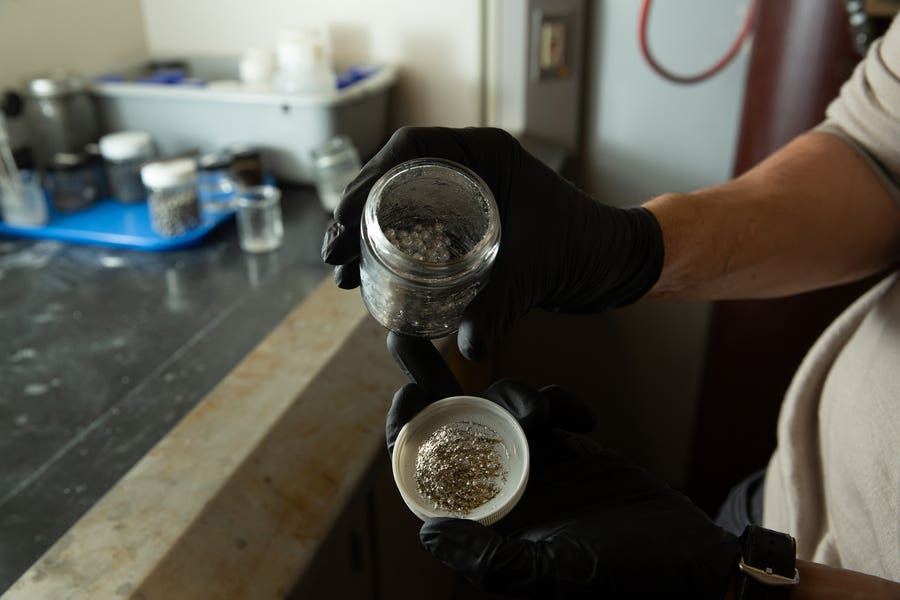Scientists create sustainable green hydrogen using soda cans and seawater
MIT’s aluminum-water process makes clean hydrogen with low emissions and cost, using scrap metal and seawater.

The new process starts with pellets of recycled aluminum (in jar) that react with seawater to produce pure hydrogen. The team found that if scaled up, the process could generate “green” hydrogen with a low-carbon footprint. (CREDIT: Tony Pulsone, MIT MechE)
Hydrogen has long been seen as the fuel of the future—a clean, efficient alternative to fossil fuels. But while it burns cleanly, most of today’s methods for making it still rely on dirty processes. The most common method, called steam methane reforming, emits 9 to 12 kilograms of carbon dioxide for every kilogram of hydrogen it produces. That’s far from green.
A new study offers a better path. Researchers at MIT have found a way to produce hydrogen using aluminum and water, with emissions that are nearly one-eighth as high. Even better, the process uses scrap metal, recycled materials, and waste heat, making it not only cleaner but cheaper and more scalable than many existing green hydrogen technologies.
The Problem with Hydrogen Today
Hydrogen can power fuel cells and internal combustion engines without releasing carbon dioxide. That makes it attractive for cars, trucks, and remote energy systems. But the gas is hard to store and transport. It has low density, is highly flammable, and must be stored in heavy, expensive tanks.
Most hydrogen today is made from natural gas, a fossil fuel. Even so-called “green hydrogen,” made with solar or wind power through electrolysis, remains costly and complex.
To be a viable climate solution, hydrogen production must become both cleaner and cheaper. That’s where the aluminum-water reaction (AWR) comes in.
The Power of Aluminum and Water
Aluminum is the most abundant metal in Earth’s crust and has exceptional energy density—about twice that of diesel and 40 times that of lithium-ion batteries by volume. When it reacts with water, it produces hydrogen gas, heat, and a solid byproduct called aluminum oxyhydroxide.
Related Stories
But there’s a catch. When aluminum touches air, it forms a thin oxide layer that stops it from reacting with water. The MIT team found a way around this. They treated aluminum pellets with a small amount of a gallium-indium alloy, which scrubs off the oxide layer. This activation lets the aluminum react easily with water—even seawater.
“We were explaining the science of this process in conferences, and the questions we would get were, ‘How much does this cost?’ and, ‘What’s its carbon footprint?’” said Aly Kombargi, a lead author of the study who earned his Ph.D. in mechanical engineering from MIT.
The researchers set out to answer those questions through a full life cycle assessment. They examined every step—from sourcing recycled aluminum to transporting hydrogen fuel to gas stations.
Cleaner, Cheaper, and Scalable
The team’s most efficient setup used recycled aluminum and seawater. They ran dozens of scenarios through a tool called Earthster, which calculates carbon emissions across supply chains. Their best result showed the process emitted just 1.45 kilograms of carbon dioxide per kilogram of hydrogen produced. That’s nearly on par with hydrogen made from solar or wind power—and far better than fossil fuel-based methods.
From a cost standpoint, this approach looks promising. The team calculated a production cost of about $9.20 per kilogram of hydrogen. That’s similar to current green hydrogen prices. And the process yields a valuable byproduct: boehmite, a form of aluminum oxide used in semiconductors and industrial materials. Selling boehmite could improve profitability by more than fivefold, according to the study.
“We’re in the ballpark of green hydrogen,” Kombargi said. “This work highlights aluminum’s potential as a clean energy source and offers a scalable pathway for low-emission hydrogen deployment in transportation and remote energy systems.”
MIT professor Douglas Hart and co-authors Brooke Bao and Enoch Ellis also contributed to the work, which was published in Cell Reports Sustainability.
How It Works
The chemical reactions behind this process are simple and well-known. When activated aluminum meets water, it breaks water molecules apart, releasing hydrogen gas and forming either boehmite or another hydroxide, depending on temperature and pressure.
The reactions look like this:
2Al + 4H₂O → 2AlOOH + 2H₂ + heat
2Al + 6H₂O → 2Al(OH)₃ + 3H₂ + heat
Each mole of aluminum releases 400 to 450 kilojoules of heat. That’s enough energy to generate hydrogen efficiently at room temperature. Roughly half of the energy comes out as heat, and the other half is stored chemically in the hydrogen gas.
The researchers even showed the process could be used in small, portable systems. They built a prototype hydrogen reactor the size of a water bottle. It uses aluminum pellets and seawater to power an electric bicycle for several hours. Future versions could power small boats or underwater vehicles using only the surrounding seawater.
A Safer Way to Store Hydrogen
One major advantage of this method is how it stores and transports hydrogen. Instead of moving flammable gas in pressurized tanks, companies could ship solid aluminum pellets. These pellets are safe, dense, and easy to handle. At the fueling station, pellets would be mixed with seawater or treated water to release hydrogen on demand.
This would be especially useful in coastal and remote regions where hydrogen infrastructure is limited. Aluminum fuel could be carried easily and safely to places where traditional fuel delivery isn’t possible.
Even better, the alloy that activates the aluminum—gallium-indium—can be recovered and reused. In saltwater, the alloy separates naturally and can be collected for future use. This adds to the process’s sustainability and cuts material costs.
Low Emissions, High Potential
The new hydrogen process lines up with growing government efforts to fight climate change. In 2024, the U.S. Environmental Protection Agency announced $4.3 billion in funding for projects that aim to cut greenhouse gas emissions. The aluminum-water reaction aligns with this goal, offering a clean, reliable, and flexible energy option.
This method also benefits from using waste materials. Recycling aluminum uses just 5% of the energy needed for primary aluminum production. That dramatically cuts emissions and costs. With better recycling and renewable energy, the process could become even more competitive.
The researchers note that upstream emissions—such as from smelting and transport—still matter. But using electric or hydrogen-powered trucks and new smelting methods could reduce these emissions by up to 25%. Advances like inert anodes and TiB₂ cathodes hold promise for cleaner aluminum production.
Next Steps
The team is now working to scale the system and refine it for commercial use. They're exploring real-world applications in transportation, off-grid energy systems, and even marine vehicles. By combining recycled materials, smart chemistry, and careful life cycle analysis, the process points to a cleaner hydrogen future.
The research was supported in part by the MIT Portugal Program. If adopted at scale, this hydrogen production method could reshape the energy landscape—turning everyday scrap into fuel for tomorrow’s engines.
Note: The article above provided above by The Brighter Side of News.
Like these kind of feel good stories? Get The Brighter Side of News' newsletter.



